Step forward to the present day; SWMBO and I have been visiting Thailand for many years and decided it was time to head out to the Death Railway as Grandad Humbug had been in Burma towards the end of WWII as part of the Allied invasion force. As far as I am aware, he only ever spoke about his experience twice: once to tell me his time there was “brutal” and the second to describe a huge python they found during a jungle patrol. Grandad survived and returned to a quiet civvy life, but left behind many comrades whom he never forgot and always went to the Cenotaph on Remembrance Day to pay his respects.
We felt it important to experience for ourselves just a very small part of what those brave men went through, pay our own respects and show that we will never forget their ultimate sacrifice.
So in February this year and with the mercury already north of 30 deg C by 0700, we left Bangkok and its horrendous pollution accompanied by a brilliant local guide, Andy, whom we’d met on a previous visit to Thailand along with his driver who expertly negotiated the gridlocked traffic and headed west for the railway some 90 miles away. It is possible to get the train from Bangkok but we opted for some air-conditioned comfort and being picked up at the front door of the hotel.
Kanchanburi War Cemetery
Kanchanaburi you will remember is at the southern end of the Burma railway and through which the 60,000 Allied POWs would pass on their way to the labour camps. For over 12,000 of these men, it was a single ticket trip and they were buried either where they fell by the side of the railway, or in the camps where so many succumbed to their injuries, malnutrition, mistreatment or illness.
After the war, it was decided to retrieve their remains whenever possible, a task managed by the Army Graves Service which later became part of the Commonwealth War Graves Commission. It’s hard to imagine just how awful this three-year long exhumation must have been for those tasked with the transfer and reburial in one of three new cemeteries dedicated to the POWs.
Kanchanburi was selected to be the southern Thailand cemetery location for Commonwealth and Dutch servicemen and contains 6,982 graves of which 6,858 have been successfully identified. No Americans are buried in either Thailand or Burma as their remains were repatriated back to the USA after the war. The ashes of 300 POWs who contracted and died from cholera are buried in two graves. A sign at the cemetery’s entrance informs visitors that the land on which it stands was a gift from the people of Thailand to be the perpetual resting place of the soldiers and airmen who are honoured there.
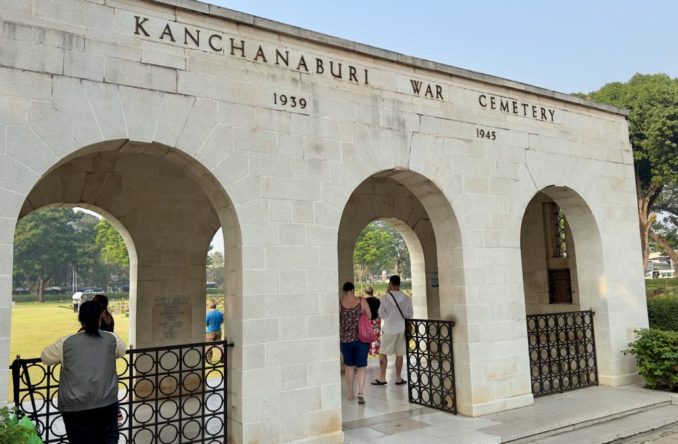
© Humbug Slocombe 2024
Management of the cemetery remains the responsibility of the CWGC and a team of locals keep it immaculately maintained, a veritable green oasis even in the height of the hot season. The original white crosses have been replaced with permanent concrete plinths, upon each sits a brass plaque stating the service number, rank, name, regiment, date of death and age of the soldier.

© Humbug Slocombe 2024
The Cross of Sacrifice, a feature at all Commonwealth War Grave locations, faces visitors who enter the cemetery and it serves as a permanent memorial to honour the Christians buried there. We spent some time just wandering around, reading the inscriptions and trying to imagine the sheer horror these young men went through before dying at the hands of their captors. Was death a welcome release for some?
The second Kanchanburi cemetery is at nearby Chungkai and was one of the base camps on the railway that also contained a hospital and church that was built by the POWs. This cemetery is the original burial ground started by the prisoners themselves and the burials are mostly of men who died at the hospital. There are now 1,426 Commonwealth and 313 Dutch servicemen buried here.

© Humbug Slocombe 2024
Thailand–Burma Railway Centre
Adjacent to the main cemetery is the Thailand–Burma Railway Centre although the large sign outside proclaims it to be the Death Railway Museum. It’s a privately-run business and is housed in the former headquarters of the Imperial Japanese Army, a building that was originally constructed by the POWs and Asian labourers. Opened some twenty years ago, it tells the complete story of the railway in a factual, non-partisan way using infographics, old photographs, models and many artefacts sourced from the railway. It’s a must-visit place for anyone in the area who is doing the railway tour.
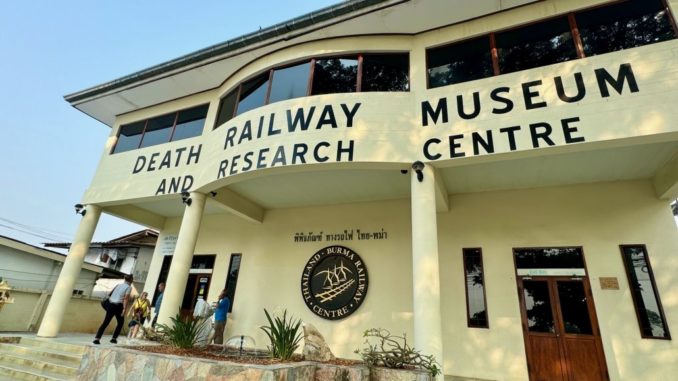
© Humbug Slocombe 2024
The mock-up of a typical railway wagon used to transport the Allied prisoners from Changi prison in Singapore is quite shocking when one realises that twenty eight men and their equipment were packed into such a small space for the four-day trip, surviving on little more than one pint of water per man per day.
To be honest, we left the museum in a somewhat sombre mood having had such a close-up look at the unimaginable conditions in which the men lived, the sheer scale of the work they performed with their bare hands and the brutality meted out to them by their captors. The photos of skeletal prisoners, otherwise normal men who could well have been our neighbours or relatives on civvy street back then before being called up, were quite shocking. But the human spirit is a strong one, most of the POWs somehow survived and this was the other thing we took away as we exited, heading for the railway itself: one must never give up hope even when faced with such an uncertain future.
The Railway
Just a couple of minutes walk from the cemetery can be found the station of Kanchanburi and it’s from here that we started the next part of our tour which was a ride on the railway itself, taking the number 257 service at 1030 out to Wang Pho, a journey of some 75 minutes.

© Humbug Slocombe 2024
The railway remains a single track but with passing loops at stations and is of a 1m gauge (1.4m in the UK) which allows for tighter bends that are necessary to navigate the twists and turns encountered further up the line alongside the rivers and through the passes. The compromise with a narrower gauge is a reduction in operating speed, it does trundle along and will never threaten a TGV in the speed stakes. Our train was full (bloody tourists!), no doubt attracted by the fixed fare of 100 Baht (£2.20) for foreigners no matter the distance travelled. Having a Thai guide definitely helped here as we were ushered through to the almost-empty carriage reserved for monks and military personnel only. Sadly there are no creature comfort concessions given to Thai VIP passengers, just hard wooden bench seats to sit on and air conditioning to help with the stifling heat/humidity provided by unglazed windows to provide a draft only when the train is moving.
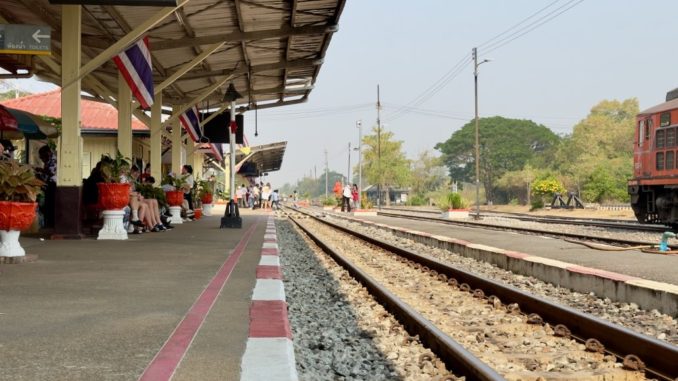
© Humbug Slocombe 2024
Just a couple of minutes after leaving the station, our train navigated a left hand bend and ahead of us was our first view of the metallic structure that is the bridge over the Khwae Yai river. Nope, no wooden structure in sight, no commando demolition team, no Colonel Saito, no Colonel Nicholson, no hot box nor any jungle such is the developed nature of Kanchanburi these days. The bridge was traversed slowly, giving the tourists who walk its span sufficient time to squeeze onto conveniently placed platforms that jut out over the water and allow the train to pass by. Our first impression was the sheer width of the slow-moving river, approximately 175m across.
We will return for more about the bridge in a while but for now it was time to sit back and enjoy the view as the train increased speed through the picturesque Thai scenery of field after field of various crops and grass but occasionally punctuated by piles of wood. On closer inspection it soon became evident these piles were actually thousands of old railway sleepers that had been removed when the track was subsequently relaid. These would have been the original sleepers put in place by the POWs and the Asian labourers some 80 years ago and now form in-situ and somewhat macabre memorials.
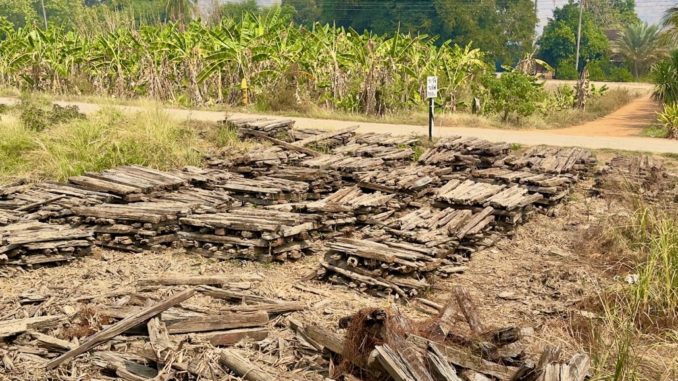
© Humbug Slocombe 2024
Wang Pho Viaduct
Our destination was Thamkra Sae, a small village alongside the snaking Khwae Noi river which has a steep cliff dropping down into the river that the POWs had to cut away to enable the construction of the Wang Pho viaduct necessary for the train line to progress up-country. This viaduct is an impressive wooden trestle structure that is 400m in length and required 2,000 prisoners working in two shifts 17 unbroken days and nights to build. Many prisoners perished due to either cliff collapses when dynamite was used for the major clearances or falls down the sheer drop into the river when hand cutting the rock or assembling the trestles.

© Humbug Slocombe 2024
It’s an awe-inspiring sight and the train slows to a crawl during the traverse allowing the passengers to marvel at what was built. Obviously it’s had some maintenance re-work since the 1940s but is essentially the same construction techniques and materials. To one side is the near-vertical cliff and below the meandering river which even in the dry, hot season was at a high level.
Once the train had departed, we were able to walk back along the tracks and over the viaduct. The Thais don’t bother with such flim-flam as health and safety weenies wearing hi-viz jackets dishing out FPNs for trespass so trying not to look down through the sleepers’ gaps into which one could fall following a stumble we walked its length. After a few photos in the midday sun (only mad dogs etc etc) we then enjoyed a fantastic Thai buffet lunch overlooking the viaduct and river before jumping back in the air-conditioned bliss of the mini-van which the driver had brought up from Kanchanaburi for the next part of the tour which was to head back there and see the bridge up close.
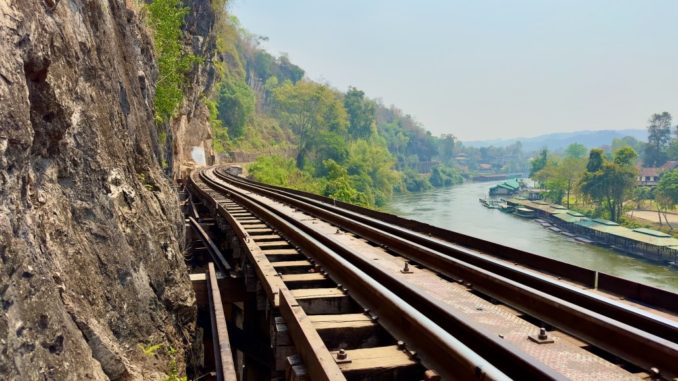
© Humbug Slocombe 2024

© Humbug Slocombe 2024
© SWMBO & Humbug Slocombe 2024



